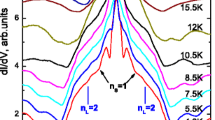We investigate the dependence of the superconducting critical temperature and the isotope coefficient on bandwidth, band-filling, and the direct Coulomb repulsion, within Eliashberg theory. The Migdal approximation is assumed throughout, and the Coulomb repulsion is modelled by the Hubbard U and treated in the simplest approximation. We assume a constant density of states with a finite bandwidth. We find that while, in principle, small isotope coefficients are possible, it is unlikely that the isotope coefficient can ever be negative within this model. Furthermore, it is difficult to achieve small isotope coefficients for realistic parameters. Finally, we discuss a possible means by which large isotope coefficients can occur at low filling.
Similar content being viewed by others
References
For a review of isotope effect measurements, see: J. P. Carbotte, On the Isotope Effect, to be published in Proceedings of Symposium on the Manifestations of the Electron-Phonon Interaction in CuO and Related Superconductors, R. Baquero, ed. (World Scientific, Singapore, 1991).
M. K. Crawford et al., Phys. Rev. B 41, 283 (1990).
J. P. Franck, et al., Physica B 169, 697 (1991).
E. Schachinger, M. G. Greeson, and J. P. Carbotte, Phys. Rev. B 42, 406 (1990).
R. Akis and J. P. Carbotte, Phys. Rev. B 41, 11661 (1990).
C. C. Tsuei et al., Phys. Rev. Lett. 65, 2724 (1990).
J. P. Carbotte, M. Greeson, and A. Perez-Gonzalez, Phys. Rev. Lett. 66, 1789 (1991).
J. C. Swihart, Phys. Rev. 116, 45 (1959).
J. Labbé and J. Friedel, J. Phys. Radium 27, 153 (1966); J. Labbé, S. Barisic, and J. Friedel, Phys. Rev. Lett. 19, 1039 (1967).
P. Morel and P. W. Anderson, Phys. Rev. 125, 1263 (1962).
J. W. Garland Jr., Phys. Rev. Lett. 11, 114 (1963).
J. P. Carbotte (private communication).
N. N. Bogoliubov, N. V. Tolmachev, and D. V. Shirkov, A New Method in the Theory of Superconductivity (Consultants Bureau, New York, 1959).
T. Holstein, Ann. Phys. 8, 325 (1959).
J. Hubbard, Proc. Roy. Soc. A 276 238 (1963).
D. J. Thouless, Ann. Phys. 10, 553 (1960).
See, for example, P. B. Allen and B. Mitrović, in Solid State Physics, H. Ehrenreich, F. Seitz, and D. Turnbull, eds. (Academic Press, New York, 1982), Vol. 37, p. 1.
J. P. Carbotte, Rev. Mod. Phys. 62, 1027 (1990).
F. Marsiglio, Physica C 160, 305 (1989).
C. S. Owen and D. J. Scalapino, Physica 55, 691 (1971).
G. Bergmann and D. Rainer, Z. Physik 263, 59 (1973).
J. E. Hirsch first suggested this possibility to the author, in the context of temperature dependent Hall coefficient calculations.
J. Kanamori, Prog. Theor. Phys. 30, 275 (1963). More recently, see H. Fukuyama and Y. Hasegawa, Prog. Theor. Phys. (Suppl.) 101, 441 (1990), and L. Chen, C. Bourbonnais, T. Li, and A.-M. S. Tremblay, Phys. Rev. Lett. 66, 369 (1991).
D. Rainer and F. J. Culetto, Phys. Rev. B 19, 2540 (1979).
Author information
Authors and Affiliations
Rights and permissions
About this article
Cite this article
Marsiglio, F. Eliashberg theory of the critical temperature and isotope effect. Dependence on bandwidth, band-filling, and direct Coulomb repulsion. J Low Temp Phys 87, 659–682 (1992). https://doi.org/10.1007/BF00118329
Received:
Issue Date:
DOI: https://doi.org/10.1007/BF00118329




